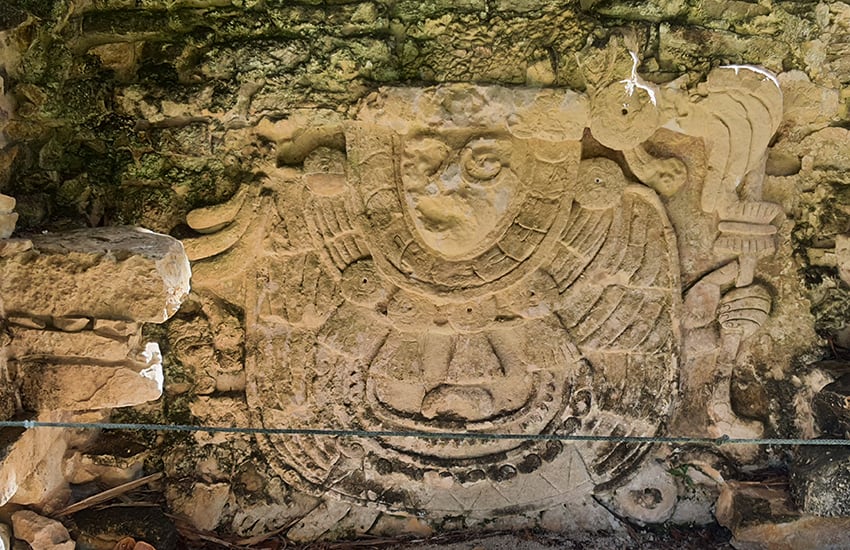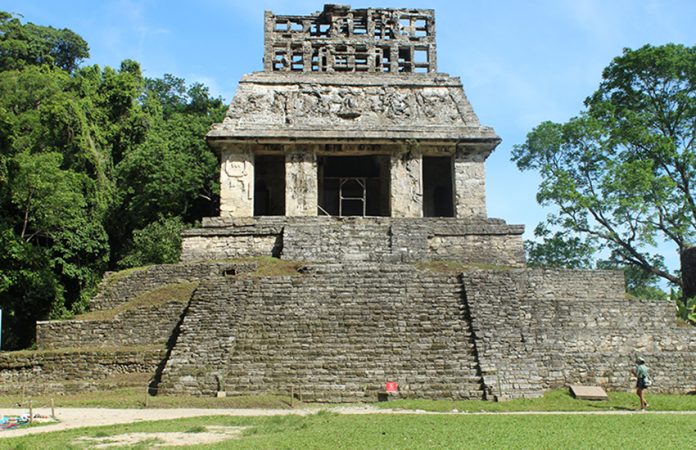Situated in the state of Chiapas, around 220 kilometers from San Cristóbal de las Casas and close to Guatemala, Palenque is considered one of the most important Maya cities of the Classic Period, between A.D. 250 and 900.
UNESCO recognized the “Pre-Hispanic City and National Park of Palenque” as a World Heritage Site in 1987. The archaeological zone, which has many well-preserved structures, is amid lush green surroundings and is perhaps one of the most beautiful ancient Maya cities in present-day Mexico.
The city’s original name has been identified as Lakamha’ (the place of the great waters). It also had several other names, including Na Chán (city of snakes). The territory under its control was called B’aakal (bone).
The modern name of Palenque derives from the nearby 16th-century settlement of Santo Domingo de Palenque.
Before it grew into a powerful Maya city, Palenque started out as a village around 150 B.C. The city’s golden era is considered to have been during A.D. 600–900, when the structures in the city’s center were constructed.

Palenque eventually became the capital of a dynasty that ruled a large area of the present-day states of Chiapas and Tabasco. The famed king, K’inich Janaab’ Pakal, called “Lord Sun Shield” and other terms, belonged to this dynasty. He ruled for 68 years in Palenque from age 12.
The National Institute of Anthropology and History (INAH) says nine males and two females ruled in Palenque from A.D. 345–603.
As you enter the archaeological zone, you will feel the refreshing surroundings of the forest, despite the usually hot climate. Near the entrance is an unexcavated temple.
Across from this mound is a series of temples where the burials of elites were discovered. To the west is the Temple of the Skull, named after a stucco relief — most likely of a rabbit — on a pillar of one of the entrances. A tomb with over 700 jade pieces was discovered there in an older structure below the temple.
To the east is another notable temple, where the famous Tomb of the Red Queen was discovered. INAH has identified her as King Pakal’s wife, Ixik Tz’aka’ab Ajaw (Lady Ruler of Generations).
Archaeologists discovered the tomb inside one of the substructures in 1994, as well as a jade mask covering the queen’s face, accessories on her body and other rich funerary offerings. The contemporary “Red Queen” name comes from the cinnabar — a red mineral discovered on her remains and the offerings and in the sarcophagus.
The Red Queen’s remains now reside next to the site at the Alberto Ruz Lhuillier Museum, named after the Mexican archaeologist who in 1952 discovered the burial site of King Pakal the Great here.
Further east is the widely photographed Temple of the Inscriptions, which contains Pakal’s sarcophagus in a burial chamber Lhuillier discovered 25 meters below the temple floor. This nine-level temple pyramid is named after three limestone slabs with hieroglyphic text. There are stucco reliefs on the pilasters to the front of the building.
The sarcophagus is said to depict scenes that include what may be a recreation of King Pakal’s death. His jade funerary mask and other accessories are displayed in the National Museum of Anthropology in Mexico City. A replica of the tomb is, however, located at the Palenque site museum.
Climbing this temple is not allowed, and the tomb was closed to the public for preservation.
North of the Temple of the Inscriptions is a beautiful square called the Central Plaza. You can observe the surroundings of the ancient city from here.
East of the plaza is a structure known as The Palace, a large complex constructed on a low platform with many buildings, courtyards and other spaces. The palace complex has many relief carvings and sculptures.

It is identified as having been an elite residential structure and an administrative and ceremonial center. The four-story tower around the center of the palace is believed to have been an observatory.
One of the palace’s many rooms — called House E — is believed to be King Pakal’s throne room. It has a stone carving called the Oval Palace Tablet depicting his crowning. Another of the palace’s notable sections is a courtyard with relief carvings of prisoners. During our visit, the palace was cordoned off to visitors.
Also by the palace, you can get a glimpse of Palenque’s water system. To the east is the Otulum stream, which begins in the mountains and runs through the site. The stream enters an underground water channel built near the palace.
Southeast of the palace is the Cross Complex, which has three temples situated around a plaza that were built by King Pakal’s son, King K’inich Kan B’ahlam II, called Lord Serpent-Jaguar II. You may hear the fascinating roars of nearby howler monkeys while exploring this area.
The three temples, each dedicated to a different deity of the triad, have shrines symbolizing steam baths — which were places of birth. Hence the temples are believed to symbolize the birthplace of each god. The three temples also have reliefs thought to depict scenes involving King Serpent-Jaguar.
East of the plaza is the Temple of the Foliated Cross. This temple has a stone tablet with a cross-like detail and other figures. North of the plaza is the largest structure within the Cross Complex: the Temple of the Cross. One of the two stone tablets inside is said to depict a god smoking tobacco.
West of the plaza is the Temple of the Sun, which features a picturesque roof comb — the crowning structure of a pyramid. Inside is a panel thought to depict scenes, including ones with King Serpent-Jaguar.
Next to the Temple of the Sun is another small temple worth seeing, built by King Serpent-Jaguar’s brother and dedicated to him. It also has a tablet depicting scenes involving King Serpent-Jaguar. Also in this section, Temple XV, where several tombs were discovered, is worth seeing.
The north group of buildings has five temples on a platform. An interesting structure here is one called the Temple of the Count, a pyramid with a temple on top, where several tombs were found. This does not refer to its function within Palenque but is named after the European explorer Jean-Frédéric Waldeck, a colorful figure who often referred to himself as a count — whether truthfully or not is unclear — and who is speculated to have lived here for a few months during his time in Palenque in the 19th century.
An absolute must-see before you leave is the Palenque site museum near the archaeological zone. It has many stunning artifacts in addition to the Red Queen Pavilion section and the replica sarcophagus of King Pakal.
Thilini Wijesinhe, a financial professional turned writer and entrepreneur, moved to Mexico in 2019 from Australia. She writes from Mérida, Yucatán. Her website can be found at https://momentsing.com/
